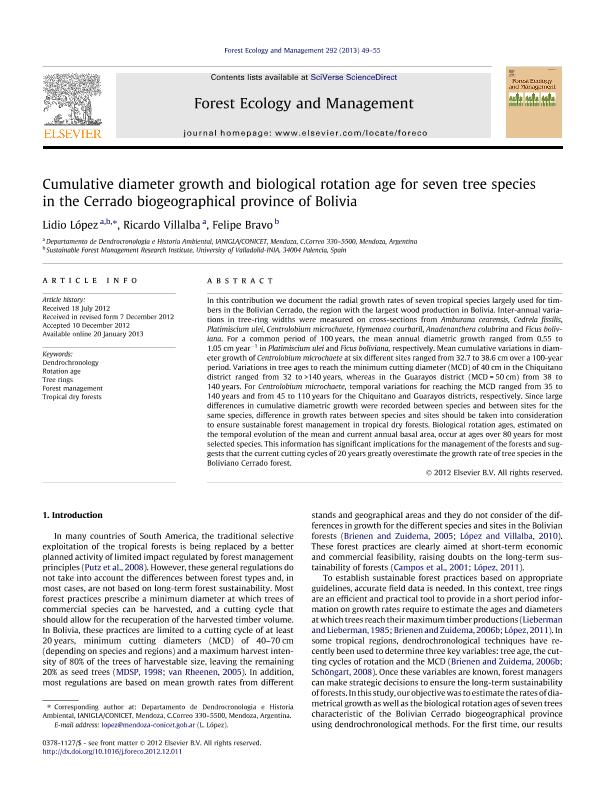Mostrar el registro sencillo del ítem
dc.contributor.author
Lopez Callejas, Lidio

dc.contributor.author
Villalba, Ricardo

dc.contributor.author
Bravo Oviedo, Felipe

dc.date.available
2015-12-17T18:28:43Z
dc.date.issued
2013-03-15
dc.identifier.citation
Lopez Callejas, Lidio; Villalba, Ricardo; Bravo Oviedo, Felipe; Cumulative diameter growth and biological rotation age for seven tree species in the Cerrado biogeographical province of Bolivia; Elsevier; Forest Ecology and Management; 292; 15-3-2013; 49-55
dc.identifier.issn
0378-1127
dc.identifier.uri
http://hdl.handle.net/11336/3012
dc.description.abstract
In this contribution we document the radial growth rates of seven tropical species largely used for timbers in the Bolivian Cerrado, the region with the largest wood production in Bolivia. Inter-annual variations in tree-ring widths were measured on cross-sections from Amburana cearensis, Cedrela fissilis, Platimiscium ulei, Centrolobium microchaete, Hymenaea courbaril, Anadenanthera colubrina and Ficus boliviana. For a common period of 100years, the mean annual diametric growth ranged from 0.55 to 1.05cmyear-1 in Platimiscium ulei and Ficus boliviana, respectively. Mean cumulative variations in diameter growth of Centrolobium microchaete at six different sites ranged from 32.7 to 38.6cm over a 100-year period. Variations in tree ages to reach the minimum cutting diameter (MCD) of 40cm in the Chiquitano district ranged from 32 to>140years, whereas in the Guarayos district (MCD=50cm) from 38 to 140years. For Centrolobium microchaete, temporal variations for reaching the MCD ranged from 35 to 140years and from 45 to 110years for the Chiquitano and Guarayos districts, respectively. Since large differences in cumulative diametric growth were recorded between species and between sites for the same species, difference in growth rates between species and sites should be taken into consideration to ensure sustainable forest management in tropical dry forests. Biological rotation ages, estimated on the temporal evolution of the mean and current annual basal area, occur at ages over 80years for most selected species. This information has significant implications for the management of the forests and suggests that the current cutting cycles of 20years greatly overestimate the growth rate of tree species in the Boliviano Cerrado forest.
dc.format
application/pdf
dc.language.iso
eng
dc.publisher
Elsevier

dc.rights
info:eu-repo/semantics/openAccess
dc.rights.uri
https://creativecommons.org/licenses/by-nc-nd/2.5/ar/
dc.subject
Rotation Age
dc.subject
Tree Rings
dc.subject
Forest Managemente
dc.subject
Tropical Dry Forest
dc.subject.classification
Silvicultura

dc.subject.classification
Agricultura, Silvicultura y Pesca

dc.subject.classification
CIENCIAS AGRÍCOLAS

dc.title
Cumulative diameter growth and biological rotation age for seven tree species in the Cerrado biogeographical province of Bolivia
dc.type
info:eu-repo/semantics/article
dc.type
info:ar-repo/semantics/artículo
dc.type
info:eu-repo/semantics/publishedVersion
dc.date.updated
2016-03-30 10:35:44.97925-03
dc.journal.volume
292
dc.journal.pagination
49-55
dc.journal.pais
Países Bajos

dc.journal.ciudad
Amsterdam
dc.description.fil
Fil: Lopez Callejas, Lidio. Consejo Nacional de Investigaciones Científicas y Técnicas. Científico Tecnológico Mendoza. Instituto Argentino de Nivología, Glaciología y Ciencias Ambientales; Argentina. Universidad de Valladolid; España
dc.description.fil
Fil: Villalba, Ricardo. Universidad de Valladolid; España. Consejo Nacional de Investigaciones Científicas y Técnicas. Científico Tecnológico Mendoza. Instituto Argentino de Nivología, Glaciología y Ciencias Ambientales; Argentina
dc.description.fil
Fil: Bravo Oviedo, Felipe. Universidad de Valladolid; España
dc.journal.title
Forest Ecology and Management

dc.relation.alternativeid
info:eu-repo/semantics/altIdentifier/url/https://www.sciencedirect.com/science/article/pii/S0378112712007347
dc.relation.alternativeid
info:eu-repo/semantics/altIdentifier/doi/http://dx.doi.org/10.1016/j.foreco.2012.12.011
Archivos asociados
